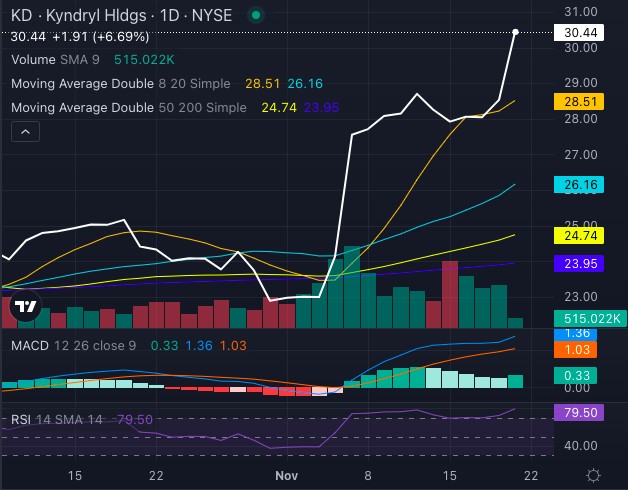Nvidia (NASDAQ: NVDA) may be heading for its biggest moment yet. The artificial intelligence (AI) chip giant is getting ready to launch its new architecture, one that could be a game changer for the industry considering the number of innovative features included in the platform. Nvidia aims to ramp production of the Blackwell architecture and chip in the fourth quarter.
This comes at a key moment for the technology company. Nvidia has built an AI empire over the past few years and grown revenue in the triple digits quarter after quarter. Now, though, as the company’s revenue levels reach extremely high points, triple-digit gains may not be sustainable. And rivals have also produced chips they hope can take market share. So, it’s logical to ask this question: Where will Nvidia be six months after the Blackwell launch? Let’s consider what history has to say — and a few other clues — and find out.

Image source: Getty Images.
What to expect from the Blackwell launch
First, a quick summary of Nvidia’s path so far and what to expect from the Blackwell launch. Nvidia has built dominance in the AI market by designing the most powerful chips and an entire platform of products and services to accompany them. So, customers can go to Nvidia simply for the chips, known as graphics processing units (GPUs), or they can get in on the entire Nvidia stack to run their data centers.
This has helped the company grow its quarterly revenue to a record $30 billion and gross margin to levels above 70%. Nvidia also has increased net income in the triple digits, reporting profit of more than $16 billion in the recent quarter.
Investors now are eagerly awaiting the Blackwell launch with high hopes thanks to the architecture’s six game-changing innovations — from Nvidia’s best chip yet to a high-performance preventative maintenance system to ensure system uptime and a fifth-generation NVLink to deliver high-speed communication among up to 576 GPUs.
As mentioned, Nvidia plans on ramping production of Blackwell in the coming weeks, and in Nvidia’s most recent earnings report, chief executive officer Jensen Huang offered us clues about customer interest in this new product. Huang said demand has surpassed supply, and he expects this to continue into next year. More recently, in an interview with CNBC, Huang reconfirmed this, calling demand for Blackwell “insane.”
Nvidia’s gross margin
All of this prompted Nvidia to forecast billions of dollars in Blackwell revenue in the fourth quarter. So Blackwell won’t take long to start adding significantly to Nvidia’s top line. On top of this, Nvidia predicts gross margin in the mid-70% range for the full year, showing us the company is capable of launching this major product while still maintaining an extremely high level of profitability.
Now let’s talk about where Nvidia may be six months after launch. History offers us an initial clue, showing us that in the six months following Nvidia’s last release of a new architecture — Hopper, back in 2022 — the stock soared nearly 100%.
A look at Nvidia’s earnings report for the period ending April 30, 2023, about six months after the Hopper launch, shows us that demand for the platform along with related products was surging. And Nvidia reported record data center revenue during the quarter. So, history offers us reason to be confident about Nvidia’s position six months after the upcoming Blackwell launch.
And a couple of other elements also make me optimistic about the period ahead. Nvidia, as it streamlines the Blackwell production process and gets past the initial launch expenses, may be able to increase margins. This may not be as early as six months post launch, but that’s OK. Since gross margin already is extremely high at more than 70%, any better than this further down the road is like icing on the cake.
Nvidia’s biggest customers have significant resources
Nvidia doesn’t release the percentage of revenue it generates from specific customers, but analyst and news reports suggest the company’s biggest customers are Microsoft, Meta Platforms, Amazon, and Alphabet. This is positive, because these players all have the resources to continue boosting their investments as the AI boom progresses.
On top of this, recent anecdotes show just how eager market giants are to get in on Nvidia products. Oracle co-founder Larry Ellison recently said he and Tesla chief Elon Musk “begged” Nvidia for more chips. This suggests that even as competitors release new chips, industry powerhouses still flock to Nvidia first.
Of course, as mentioned above, Nvidia may not report triple-digit growth every quarter as it’s done recently. So, six months after the Blackwell launch, we could be looking at a slower growth rate than the one Nvidia has delivered in the past. But this is because Nvidia already has increased its revenue to mind-blowing levels, making it difficult to keep gaining at such a pace. So, a slowdown shouldn’t be seen as negative.
All of this means that, six months after the Blackwell launch, Nvidia still may be racing to catch up with enormous demand — but the company also might report billion-dollar revenue from the platform and solid earnings growth. This also could translate into fantastic stock performance. But even if the shares don’t rise as they did following the Hopper launch, Nvidia is well positioned to score a win for investors over the long term.
Should you invest $1,000 in Nvidia right now?
Before you buy stock in Nvidia, consider this:
The Motley Fool Stock Advisor analyst team just identified what they believe are the 10 best stocks for investors to buy now… and Nvidia wasn’t one of them. The 10 stocks that made the cut could produce monster returns in the coming years.
Consider when Nvidia made this list on April 15, 2005… if you invested $1,000 at the time of our recommendation, you’d have $867,372!*
Stock Advisor provides investors with an easy-to-follow blueprint for success, including guidance on building a portfolio, regular updates from analysts, and two new stock picks each month. The Stock Advisor service has more than quadrupled the return of S&P 500 since 2002*.
*Stock Advisor returns as of October 21, 2024
John Mackey, former CEO of Whole Foods Market, an Amazon subsidiary, is a member of The Motley Fool’s board of directors. Suzanne Frey, an executive at Alphabet, is a member of The Motley Fool’s board of directors. Randi Zuckerberg, a former director of market development and spokeswoman for Facebook and sister to Meta Platforms CEO Mark Zuckerberg, is a member of The Motley Fool’s board of directors. Adria Cimino has positions in Amazon, Oracle, and Tesla. The Motley Fool has positions in and recommends Alphabet, Amazon, Meta Platforms, Microsoft, Nvidia, Oracle, and Tesla. The Motley Fool recommends the following options: long January 2026 $395 calls on Microsoft and short January 2026 $405 calls on Microsoft. The Motley Fool has a disclosure policy.



